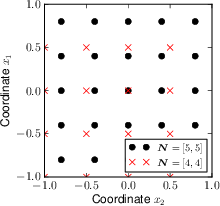Users guide¶
Installation¶
There is no special installation required. It can be downloaded from https://github.com/vondrejc/FFTHomPy.git or using Git by:
git clone https://github.com/vondrejc/FFTHomPy.git
The code is implemented in python and supports versions 2 and 3.
Running the program¶
Command line usage:
$ python main.py examples/scalar/scalar_2d.py
or only as:
$ ./main.py examples/scalar/scalar_2d.py
where examples/scalar/scalar_2d.py is an input file for FFTHomPY.
Definition of input file¶
Input file for FFTHomPy consists of material definition and problem definition.
Material definition¶
Material coefficients can be defined as matrix-inclusion composites or grid-based composites.
Matrix-inclusions composites¶
In this case, material is expressed at points  of periodic cell
of periodic cell  as
as

where functions  describe inclusion topologies located at
describe inclusion topologies located at  with material coefficients
with material coefficients  .
An example of material coefficients is named
.
An example of material coefficients is named 'square'
import numpy as np
materials = {'square': {'Y': np.ones(dim),
'inclusions': ['square', 'otherwise'],
'positions': [np.zeros(dim), ''],
'params': [0.6*np.ones(dim), ''],
'vals': [11*np.eye(dim), 1.*np.eye(dim)]}}
and the used keywords have following meanings:
'Y':numpy.arrayof shape(dim,)describes the size of periodic cellin dimension
dim
'inclusions': list of inclusionsof following types
'square','circle', and'otherwise'in two-dimensional settings'cube','ball', and'otherwise'in two-dimensional settings
'positions': list of positionscorresponding to individual inclusions
- the position corresponds to center of gravity with respect to coordinate system; the inclusion
'otherwise'has no position because it represents the area in periodic cell omitted by inclusions
'params': list of parameters determining the inclusions
- for
'square'and'cube', it corresponds to sizes of individual sides- for
'circle'and'ball', it corresponds to diameter
'vals': list of material coefficients for individual inclusions; coefficients are represented asnumpy.arrayof shape corresponding to physical problem according to problem definition; for scalar elliptic problem, the shape is(dim, dim)while for linearized elasticity the shape is(D, D)whereD = dim*(dim+1)/2.
Grid-based composites¶
Contrary to Matrix-inclusions composites, grid-based composites are defined on grid points:

for some number of points  and the size
and the size  of periodic cell
of periodic cell  ; examples for odd and even grids are depicted in following figure
; examples for odd and even grids are depicted in following figure

for periodic cell  with the cell size
with the cell size  .
.
The material is then approximated with the following formula
(1)
where function  is taken either by
is taken either by
(2)
leading to piece-wise constant approximation of material coefficients, or by
(3)
leading to piece-wise bilinear approximation of material coefficients.
In comparison to Matrix-inclusions composites, the material coefficients definition
materials.update({'square_Ga': {'Y': np.ones(dim),
'inclusions': ['square', 'otherwise'],
'positions': [np.zeros(dim), ''],
'params': [0.6*np.ones(dim), ''],
'vals': [11*np.eye(dim), 1.*np.eye(dim)],
'order': 0,
'P': 5*np.array(dim)}})
Problem definition¶
Here, the example of problem description is stated:
problems = [{'name': 'prob1',
'physics': 'scalar',
'material': 'square',
'solve': {'kind': 'GaNi',
'N': N,
'primaldual': ['primal', 'dual']},
'postprocess': [{'kind': 'GaNi'},
{'kind': 'Ga',
'order': None},
{'kind': 'Ga',
'order': 0,
'P': N},
{'kind': 'Ga',
'order': 1,
'P': 27*N}],
'solver': {'kind': 'CG',
'tol': 1e-6,
'maxiter': 1e3}}]
- The individual keywords are explained:
'name': the name of a problem'physics': defines the physical problem that is solved; following alternatives are implemented:'scalar': scalar linear elliptic problem (diffusion, stationary heat transfer, or electric conductivity)'elasticity': linearized elasticity (small strain)
'material': keyword refering to dictionarymaterialsor directly dictionary defining the material coefficients'solve': defines the problem discretization, the way how to solve minizers (corrector functions)'kind': is either'Ga'(Galerkin approximation) or'GaNi'(Galerkin approximation with numerical integration); it thus corresponds to the discretizaiton way'N': is anumpy.arraydefining the approximation order of trigonometric polynomials; the higher the value is, the better approximation is provided'primaldual': determine if primal, dual, or both formulations are calculated
'solver': defines the linear solver and relating parameters'kind': linear solver one of'CG'for Conjugate gradients,'BiCG'for Biconjugate gradients,'richardson'for Richardson’s iterative solution,'scipy_cg'forscipy.sparse.linalg.cg, and'scipy_bicg'forscipy.sparse.linalg.bicg,'tol': the required tolerance (float) for the convergence of linear solver'maxit': the maximal number of iterations
'postprocess': defines the way for calculating homogenized material coefficients from minimizers that are obtained with a way defined in'solver''kind': is either'Ga'(Galerkin approximation) or'GaNi'(Galerkin approximation with numerical integration); it thus corresponds to the discretizaiton way'order': applicable only for'Ga', it defines approximation order according to (2) or (3)'P': applicable only for'Ga', thisnumpy.arrayof shape(dim,)describes the resolution of approximation in (1)